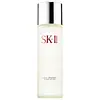What's inside
What's inside
 Key Ingredients
Key Ingredients

 Benefits
Benefits

 Concerns
Concerns

 Ingredients Side-by-side
Ingredients Side-by-side

Water
Skin ConditioningPropylene Glycol
HumectantGlycerin
HumectantPentylene Glycol
Skin ConditioningOleth-20
CleansingPEG-7 Glyceryl Cocoate
EmulsifyingAlgae Extract
EmollientGlycoproteins
Skin ConditioningPanax Ginseng Root Extract
EmollientEquisetum Arvense Extract
AstringentCucumis Sativus Fruit Extract
EmollientAnthemis Nobilis Flower Extract
MaskingLactobacillus Ferment
Skin ConditioningUrea
BufferingSaccharide Hydrolysate
HumectantMagnesium Aspartate
Skin ConditioningGlycine
BufferingButylene Glycol
HumectantBenzophenone-4
UV AbsorberAlanine
MaskingCreatine
Skin ConditioningPEG-40 Hydrogenated Castor Oil
EmulsifyingAllantoin
Skin ConditioningCitric Acid
BufferingXanthan Gum
EmulsifyingSaccharomyces Cerevisiae Extract
Skin ConditioningTetrasodium EDTA
Ethylhexylglycerin
Skin ConditioningParfum
MaskingCitronellol
PerfumingAlpha-Isomethyl Ionone
PerfumingGeraniol
PerfumingPhenoxyethanol
PreservativeMethylparaben
PreservativeSodium Dehydroacetate
PreservativeCI 60730
Cosmetic ColorantWater, Propylene Glycol, Glycerin, Pentylene Glycol, Oleth-20, PEG-7 Glyceryl Cocoate, Algae Extract, Glycoproteins, Panax Ginseng Root Extract, Equisetum Arvense Extract, Cucumis Sativus Fruit Extract, Anthemis Nobilis Flower Extract, Lactobacillus Ferment, Urea, Saccharide Hydrolysate, Magnesium Aspartate, Glycine, Butylene Glycol, Benzophenone-4, Alanine, Creatine, PEG-40 Hydrogenated Castor Oil, Allantoin, Citric Acid, Xanthan Gum, Saccharomyces Cerevisiae Extract, Tetrasodium EDTA, Ethylhexylglycerin, Parfum, Citronellol, Alpha-Isomethyl Ionone, Geraniol, Phenoxyethanol, Methylparaben, Sodium Dehydroacetate, CI 60730
 Reviews
Reviews

Ingredients Explained
These ingredients are found in both products.
Ingredients higher up in an ingredient list are typically present in a larger amount.
Butylene Glycol (or BG) is used within cosmetic products for a few different reasons:
Overall, Butylene Glycol is a safe and well-rounded ingredient that works well with other ingredients.
Though this ingredient works well with most skin types, some people with sensitive skin may experience a reaction such as allergic rashes, closed comedones, or itchiness.
Learn more about Butylene GlycolCitric Acid is an alpha hydroxy acid (AHA) naturally found in citrus fruits like oranges, lemons, and limes.
Like other AHAs, citric acid can exfoliate skin by breaking down the bonds that hold dead skin cells together. This helps reveal smoother and brighter skin underneath.
However, this exfoliating effect only happens at high concentrations (20%) which can be hard to find in cosmetic products.
Due to this, citric acid is usually included in small amounts as a pH adjuster. This helps keep products slightly more acidic and compatible with skin's natural pH.
In skincare formulas, citric acid can:
While it can provide some skin benefits, research shows lactic acid and glycolic acid are generally more effective and less irritating exfoliants.
Most citric acid used in skincare today is made by fermenting sugars (usually from molasses). This synthetic version is identical to the natural citrus form but easier to stabilize and use in formulations.
Read more about some other popular AHA's here:
Learn more about Citric AcidGlycerin is already naturally found in your skin. It helps moisturize and protect your skin.
A study from 2016 found glycerin to be more effective as a humectant than AHAs and hyaluronic acid.
As a humectant, it helps the skin stay hydrated by pulling moisture to your skin. The low molecular weight of glycerin allows it to pull moisture into the deeper layers of your skin.
Hydrated skin improves your skin barrier; Your skin barrier helps protect against irritants and bacteria.
Glycerin has also been found to have antimicrobial and antiviral properties. Due to these properties, glycerin is often used in wound and burn treatments.
In cosmetics, glycerin is usually derived from plants such as soybean or palm. However, it can also be sourced from animals, such as tallow or animal fat.
This ingredient is organic, colorless, odorless, and non-toxic.
Glycerin is the name for this ingredient in American English. British English uses Glycerol/Glycerine.
Learn more about GlycerinMethylparaben is a preservative and is a paraben. It is used to prevent the growth of fungus, mold, and other harmful bacteria. Parabens are chemicals used as preservatives in both cosmetics and food.
Methylparaben can be synthetically created. It can also be found naturally in some fruits, such as blueberries.
Oftentimes, Methylparaben is combined with other parabens to help increase the shelf life.
The safety of Methylparaben is currently being studied. While ongoing studies are looking into the safety of parabens, the results have been very mixed. Some studies have not found Methylparaben to be harmful.
Learn more about MethylparabenWater. It's the most common cosmetic ingredient of all. You'll usually see it at the top of ingredient lists, meaning that it makes up the largest part of the product.
So why is it so popular? Water most often acts as a solvent - this means that it helps dissolve other ingredients into the formulation.
You'll also recognize water as that liquid we all need to stay alive. If you see this, drink a glass of water. Stay hydrated!
Learn more about Water